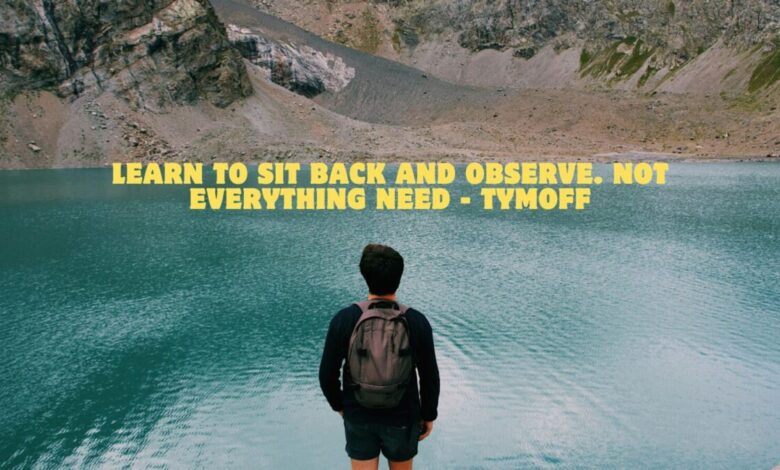Learn to Sit Back and Observe Not Everything Needs Fixing Tymoff

Learning to sit back and observe is important in our busy world. Not everything needs fixing, and this idea is central to “Learn to Sit Back and Observe Not Everything Needs Fixing Tymoff.” When we pause and watch without rushing to solve problems, we can understand things better. It helps us see what’s really happening around us.
Sitting back allows us to relax and see things more clearly. We often feel the need to fix everything quickly, but sometimes it’s better to let things unfold on their own. This approach not only reduces stress but also helps us learn more about the situations and people around us.
Understanding the Value of Observation: Not Everything Needs Fixing – Tymoff
Learning to sit back and observe is a powerful skill. When you understand the value of observation, you realize that not everything needs fixing. This approach helps you see things more clearly. By stepping back, you can notice small details that you might miss if you rush to fix problems.
Observing without jumping in lets you see the bigger picture. You can understand situations better by watching how they develop on their own. This way, you gain a clearer perspective and avoid acting too quickly. It’s a chance to see what really matters without getting caught up in the need to fix everything.
When you learn to sit back and observe, you also give yourself a break. Instead of constantly fixing problems, you allow yourself time to relax and reflect. This can help reduce stress and lead to better decision-making in the long run. Observing patiently provides you with valuable insights and a chance to understand the situation more deeply.
Why Sitting Back Can Be Beneficial: Learn to Observe – Tymoff
Sitting back and observing is beneficial because it helps you avoid unnecessary stress. When you learn to observe without rushing in, you take time to understand what’s happening around you. This approach reduces the pressure to always fix problems immediately.
Another benefit of sitting back is gaining a fresh perspective. By watching without intervening, you can see the situation from different angles. This helps you make better decisions and understand the underlying causes of issues. It’s about letting things unfold naturally and learning from the process.
In addition, sitting back allows you to appreciate the present moment. Instead of focusing on fixing problems, you can enjoy the experience and learn from it. This shift in focus helps you relax and reduces the urge to control everything. Observing patiently leads to greater awareness and understanding of your surroundings.
How to Effectively Observe Without Intervening
To effectively observe without intervening, start by adopting a non-judgmental attitude. Avoid jumping to conclusions or making quick judgments. Instead, try to understand what’s happening without labeling it as good or bad.
Next, focus on being present in the moment. Pay attention to the details around you without letting your mind wander. This means observing with all your senses—seeing, hearing, and even feeling what’s happening. Being fully engaged helps you notice important aspects that might be missed otherwise.
Lastly, practice patience. Observing without intervening requires letting things unfold naturally. Resist the urge to fix problems right away and instead, watch how situations develop. This patience allows you to gain deeper insights and a better understanding of what’s really going on.
Benefits of Sitting Back and Observing: A Tymoff Perspective
Sitting back and observing has many benefits, as highlighted by Tymoff. One major benefit is reduced stress. When you take a step back, you avoid the constant pressure to fix every problem. This helps you relax and manage stress more effectively.
Another benefit is improved clarity. Observing without intervening gives you a clearer view of the situation. You can see patterns and details that might be missed if you’re too focused on fixing things. This clarity leads to better decision-making and understanding.
Additionally, sitting back can boost creativity. When you’re not constantly trying to solve problems, your mind has space to think creatively. This relaxed state often leads to new ideas and innovative solutions. Observing calmly helps your mind to explore new possibilities.
Learning Life Lessons Through Observational Sitting Back
Observational sitting back teaches valuable life lessons. By watching without interfering, you learn about complex situations and their dynamics. This approach helps you understand how different factors interact and influence each other.
You also gain insights into your own behavior. Observing situations from a distance allows you to see your habitual responses and tendencies. This self-awareness helps you identify areas for personal growth and improvement.
Moreover, observational sitting back enhances empathy. By watching how others behave and react, you develop a deeper understanding of their perspectives and motivations. This increased empathy improves your relationships and interactions with others.
Tips for Mastering the Art of Observational Sitting Back – Tymoff
To master the art of observational sitting back, start by adopting a non-reactive mindset. Avoid jumping to conclusions or making quick judgments about what you observe. Instead, try to remain open and curious.
Next, focus on being fully present. Pay close attention to what’s happening around you without letting your mind drift. Engaging all your senses helps you notice important details and nuances.
Additionally, practice patience and resist the urge to intervene. Allow situations to develop naturally and observe how things unfold. This patience helps you gain a better understanding of the situation and its outcomes.
How Observation Enhances Creativity and Innovation
Observation can significantly enhance creativity and innovation. When you take time to sit back and watch, you create space for your mind to think freely. This relaxed state encourages new ideas and unique perspectives.
By observing without interference, you also gain insights into different approaches and solutions. Watching how others solve problems and handle situations provides inspiration for your own creative thinking.
Furthermore, observation helps you see connections between seemingly unrelated ideas. This ability to link different concepts leads to innovative solutions and creative breakthroughs. Observing patiently allows your mind to explore new possibilities.
Gaining Cultural Insights Through Observation: Tymoff’s Approach
Gaining cultural insights through observation is valuable. By observing different cultural environments without judgment, you can better understand and appreciate diverse practices and traditions.
Observing with an open mindset helps you notice subtle behaviors and communication styles that you might otherwise overlook. This deeper understanding fosters empathy and reduces cultural biases.
Additionally, observing various cultures allows you to challenge your own assumptions and preconceptions. This approach broadens your perspective and enhances your ability to interact respectfully and effectively with people from different backgrounds.
Recognizing Your Own Habits Through Observational Sitting Back
Observational sitting back helps you recognize your own habits and tendencies. By watching how you react to different situations, you gain insight into your automatic responses and behaviors.
This self-awareness is crucial for personal growth. Understanding your habitual patterns allows you to identify areas where you may need to make changes or improvements.
Moreover, observing yourself in various contexts helps you address blind spots and develop a more balanced approach to different situations. This reflective practice enhances your overall self-knowledge and personal development.
Improving Community Insights by Watching Quietly – Tymoff
Improving community insights by watching quietly can be very beneficial. By observing social dynamics and interactions without participating, you gain a clearer understanding of community behaviors and relationships.
This approach helps you see underlying patterns and issues that may not be apparent through casual involvement. Observing quietly reveals the nuances of community interactions and power structures.
Additionally, this observational perspective helps you identify areas where you can contribute positively. Understanding community dynamics allows you to address challenges more effectively and build stronger connections within the community.
How Sitting Back Helps in Stress Management and Wellness
Sitting back and observing plays a key role in stress management and wellness. By removing yourself from the constant need to fix problems, you reduce stress and create space for relaxation.
This approach activates the parasympathetic nervous system, which promotes relaxation and supports overall health. Observing calmly helps lower cortisol levels and reduces anxiety, leading to improved physical well-being.
Furthermore, sitting back allows you to manage stress more effectively by focusing on the present moment. This mindfulness practice enhances your overall sense of balance and wellness.
Conclusion
In a world full of constant activity, learning to sit back and observe is a valuable skill. Not everything needs fixing, and by adopting this mindset, you gain clarity and reduce stress. Observing without intervening allows you to understand situations better and appreciate the present moment.
Integrating observational sitting back into your routine can lead to greater personal growth and improved well-being. It helps you make better decisions, fosters empathy, and enhances creativity. Embracing this approach enriches your life and provides valuable insights into your surroundings.



